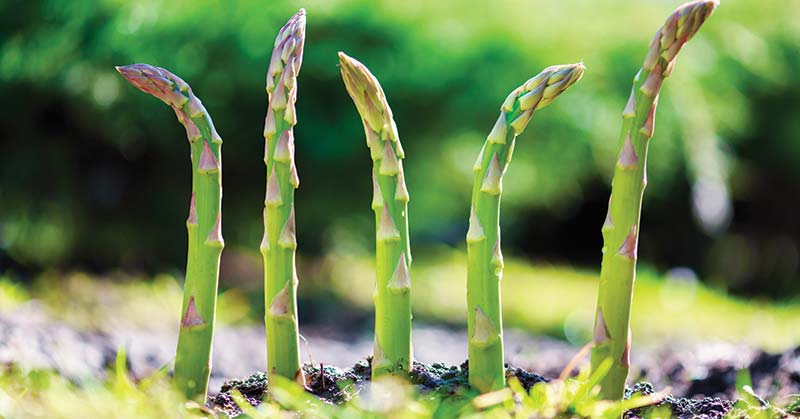Asparagus, with its delicate spears and lush fern-like foliage, is a perennial vegetable that deserves a place in every home garden. Its cultivation can be immensely rewarding, offering a bounty of fresh spears for many years.
If you’re ready to embark on the journey of planting asparagus starts, this guide will take you through each step, ensuring a successful and bountiful harvest.
Understanding Asparagus
Before diving into the planting process, it’s essential to understand asparagus and its growth requirements. Asparagus (Asparagus officinalis) is a perennial plant that can produce for 20 years or more.
It prefers well-drained soil, full sun, and a temperate climate. There are male and female plants, but newer hybrid varieties are predominantly male for increased yield.
Selecting Your Asparagus Variety
Choosing the right variety is crucial for success. Popular varieties include ‘Jersey Knight’, ‘Purple Passion’, and ‘Mary Washington’. Consult your local nursery or extension office to find the best variety for your region.
Preparing the Planting Site
- Soil Preparation: Asparagus thrives in well-drained soil. Prepare your garden bed by removing weeds and incorporating plenty of organic matter. The soil pH should be between 6.5 and 7.0.
- Site Selection: Choose a sunny spot. Asparagus needs at least 6-8 hours of direct sunlight daily.
Planting Asparagus Starts
- When to Plant: Plant asparagus crowns in early spring, as soon as the soil can be worked.
- Planting Depth and Spacing: Dig trenches about 12 inches wide and 6-8 inches deep. Space the trenches 3-4 feet apart. In the trench, create small mounds every 18 inches.
- Placing the Crowns: Drape the roots of each crown over a mound, spreading them evenly. Cover with 2-3 inches of soil. As the asparagus grows, gradually fill in the trench with soil, but do not cover the growing spears.
Post-Planting Care
- Watering: Keep the soil consistently moist but not waterlogged during the growing season.
- Mulching: Apply a layer of organic mulch to retain moisture and suppress weeds.
- Feeding: Fertilize with a balanced fertilizer in early spring and again after the harvest season.
- Weeding: Keep the bed free from weeds without disturbing the shallow roots of the asparagus.
Patience is Key
Remember, asparagus requires patience. Avoid harvesting in the first year, and only do light harvesting in the second year. This allows the plants to establish a strong root system.
Harvesting Asparagus
From the third year onward, you can enjoy a full harvest. Harvest asparagus spears when they are about 6-8 inches tall and before the tips start to open. Cut or snap them off at ground level.
Winter Care
In fall, after the foliage has yellowed, cut it back to ground level. Apply a layer of mulch to protect the crowns through the winter.
Conclusion
Planting asparagus may require a bit of patience and care, but the reward of fresh, tender spears each spring makes it all worthwhile. With the right preparation and care, your asparagus bed will be a source of delight for many years to come.
FAQs on How do you Plant Asparagus Starts
Q: When is the best time to plant asparagus starts?
A: The ideal time to plant asparagus starts is in early spring, as soon as the soil can be worked.
Q: How deep should I plant asparagus crowns?
A: Asparagus crowns should be planted in trenches that are about 6-8 inches deep.
Q: What kind of soil is best for growing asparagus?
A: Asparagus thrives in well-drained soil rich in organic matter, with a pH between 6.5 and 7.0.
Q: How much space do I need between asparagus plants?
A: Space asparagus crowns about 18 inches apart in rows that are 3-4 feet apart.
Q: Do I need to water asparagus plants regularly?
A: Yes, asparagus needs consistent moisture, especially during the growing season. Water enough to keep the soil moist but not waterlogged.
Q: When can I start harvesting asparagus?
A: You should wait until the third year after planting to start a full harvest. This allows the plants to establish a strong root system.
Q: How do I harvest asparagus?
A: Harvest asparagus spears when they are about 6-8 inches tall by cutting or snapping them off at ground level.
Q: Is it necessary to mulch asparagus beds?
A: Yes, applying organic mulch helps retain moisture, regulate soil temperature, and suppress weeds.
Q: Can I grow asparagus in a container?
A: It is challenging to grow asparagus in containers due to its deep root system and perennial nature. It’s best grown in-ground or in raised beds.
Q: How do I prepare my asparagus bed for winter?
A: After the foliage yellows in the fall, cut it back to ground level. Apply a layer of mulch to protect the crowns during winter.




